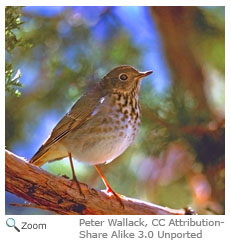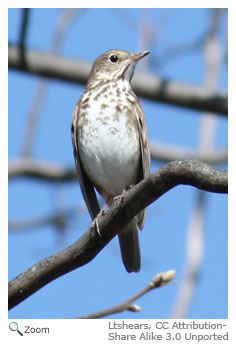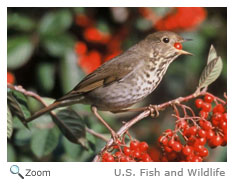Description
 The Hermit Thrush is difficult to see but easy to hear in its wooded habitat. It has a medium brown head, back and wings and a speckled white throat and belly. Its long, reddish tail helps people tell it apart from other thrushes. It has a clear, lovely song that can be heard in the winter throughout much of North America. The Hermit Thrush is difficult to see but easy to hear in its wooded habitat. It has a medium brown head, back and wings and a speckled white throat and belly. Its long, reddish tail helps people tell it apart from other thrushes. It has a clear, lovely song that can be heard in the winter throughout much of North America.
Range
The Hermit Thrush is migratory. Depending on the season, it can be seen in almost all of North America. In the spring and summer, the Hermit Thrush can be found in Alaska, much of the Southern half of Canada and into the Western and Northeastern United States. Its winter range extends throughout the southern half of the United States, into Central America and along the west coast of the United States. The Hermit Thrush can be seen in the Midwest during migration.
Habitat
 With such a large range, the Hermit Thrush also lives in many different habitats. For breeding, it prefers open areas inside forests, such as ponds, meadows and trails. During the winter, the Hermit Thrush lives in lower elevations with dense brush cover, plentiful insects and plants with berries. With such a large range, the Hermit Thrush also lives in many different habitats. For breeding, it prefers open areas inside forests, such as ponds, meadows and trails. During the winter, the Hermit Thrush lives in lower elevations with dense brush cover, plentiful insects and plants with berries. |
|
Diet
 During the breeding season, the Hermit Thrush forages on the ground for insects such as beetles, caterpillars, bees, ants and flies. In the winter, wild berries become a main portion of the Hermit Thrush's diet. During the breeding season, the Hermit Thrush forages on the ground for insects such as beetles, caterpillars, bees, ants and flies. In the winter, wild berries become a main portion of the Hermit Thrush's diet.
Life Cycle
 Breeding begins in April or May. The female builds a nest either on the ground or in the crook of a small tree. The cup-shaped nest is made of grass, leaves, pine needles and lichens and is lined with finer plant materials. The female lays 3-6 light blue eggs, which she incubates for 11-13 days. After hatching, the male brings food to the nest which the female then feeds to the chicks. Young chicks first leave the nest after 10-15 days. Breeding begins in April or May. The female builds a nest either on the ground or in the crook of a small tree. The cup-shaped nest is made of grass, leaves, pine needles and lichens and is lined with finer plant materials. The female lays 3-6 light blue eggs, which she incubates for 11-13 days. After hatching, the male brings food to the nest which the female then feeds to the chicks. Young chicks first leave the nest after 10-15 days.
The Hermit Thrush usually has two broods per season.
Behavior
 East of the Rocky Mountains, the Hermit Thrush usually builds a nest on the ground. In the West, it is more likely to build a nest in a tree. East of the Rocky Mountains, the Hermit Thrush usually builds a nest on the ground. In the West, it is more likely to build a nest in a tree. |





